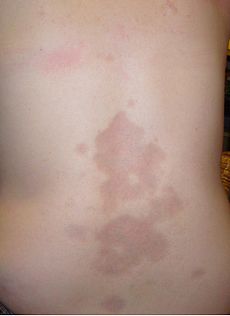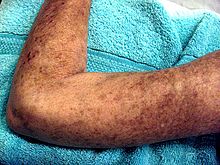- Scleroderma
-
This article is about the disease. For the mushroom, see Scleroderma (genus). Not to be confused with the skin disease scleredema.
Scleroderma Classification and external resources ICD-10 L94.0-L94.1, M34 ICD-9 701.0 710.1 Scleroderma is a chronic systemic autoimmune disease (primarily of the skin) characterized by fibrosis (or hardening), vascular alterations, and autoantibodies. There are two major forms:
Limited systemic sclerosis/scleroderma involves cutaneous manifestations that mainly affect the hands, arms and face. Previously called CREST syndrome in reference to the following complications: Calcinosis, Raynaud's phenomenon, Esophageal dysfunction, Sclerodactyly, and Telangiectasias. Additionally, pulmonary arterial hypertension may occur in up to one third of patients and is the most serious complication for this form of scleroderma.
Diffuse systemic sclerosis/scleroderma is rapidly progressing and affects a large area of the skin and one or more internal organs, frequently the kidneys, esophagus, heart and lungs. This form of scleroderma can be quite disabling. There are no treatments for scleroderma itself, but individual organ system complications are treated.[1][2]
Other forms of scleroderma include systemic sine scleroderma, which lacks skin changes, but has systemic manifestations, and two localized forms which affect the skin, but not the internal organs: morphea, and linear scleroderma.
The prognosis is generally good for limited cutaneous scleroderma patients who escape pulmonary complications, but is worse for those with the diffuse cutaneous disease, particularly in older age, and for males. Death occurs most often from pulmonary, heart and kidney complications. In diffuse cutaneous disease, five-year survival is 70%, 10-year survival is 55%.[3]
The cause is unknown. Scleroderma runs in families, but the genes have not been identified. It affects the small blood vessels (arterioles) in all organs. First, the endothelial cells of the arteriole die off, along with smooth muscle cells, by a process of apoptosis. They are replaced by collagen and other fibrous material. Inflammatory cells, particularly CD4+ helper T cells, infiltrate the arteriole, and cause further damage. Many of the inflammatory and destructive protein signals have been identified, and they are potential targets for drugs that could interrupt the process.[1]
Contents
Classification
Scleroderma is characterized by the appearance of circumscribed or diffuse, hard, smooth, ivory-colored areas that are immobile, and which give the appearance of hidebound skin, a disease occurring in both localized and systemic forms:[4]
- Localized scleroderma
- Localized morphea
- Morphea-lichen sclerosus et atrophicus overlap
- Generalized morphea
- Atrophoderma of Pasini and Pierini
- Pansclerotic morphea
- Morphea profunda
- Linear scleroderma
- Systemic scleroderma
Diagnosis
Typical scleroderma is classically defined as symmetrical skin thickening, with about 90% of cases also presenting with Raynaud's phenomenon, nail-fold capillary changes, and antinuclear antibodies. Patients may or may not experience systemic organ involvement. Atypical scleroderma may show any variation of these changes without skin changes or with finger swelling only.[5][6] Additional symptoms of scleroderma typically present themselves within two years of Raynaud's phenomenon.[7]
Laboratory testing can show antitopoisomerase antibodies (causing a diffuse systemic form), or anticentromere antibodies (causing a limited systemic form, and the CREST syndrome). Other autoantibodies can be seen, such as anti-U3 or anti-RNA polymerase.
Severe complications from scleroderma include:
- Heart: Untreated high blood pressure strains the heart; irregular heart rhythm and enlargement of the heart lead to heart failure.
- Kidney: Scleroderma renal crisis in which malignant hypertension develops and causes acute renal failure was once a common cause of death, but is now treatable with ACE inhibitors.
- Lung: Two-thirds of all patients suffer from respiratory problems, such as shortness of breath, coughing, difficulty breathing, alveolitis (inflammation of lung air sacs), pneumonia, and cancer.
- Digestive: Esophagus damage can make it difficult to swallow food, and acid reflux is common. The stomach can develop gastric antral vascular ectasia (GAVE), which occasionally may bleed profusely. A sluggish intestine may cause pain and bloating; undigested food can result in diarrhea, weight loss and anemia.
- Skin and joints: Carpal tunnel syndrome is common, as are muscle weakness, joint pain, and stiffness.[7]
- Mouth: flat white patches, loss of attached gingival mucosa, gingival recession, and diffuse widening of the periodontal ligament (PDL) space are seen. Dysphagia may result from collagen deposition in the lingual and esophageal submucosa. Resorption of posterior ramus of the mandible, coronoid process, and condyle are seen due to pressure from abnormal collagen production in adjacent areas. Inelasticity of the mouth may make dentures or dental prosthesis difficult to insert and remove.[8]
Treatment
There is no direct cure for scleroderma. Because the exact cause is unknown, any treatment is patient-specific and aimed at ameliorating symptoms of the disease. For example, patients who experience Raynaud's phenomenon may be treated with agents to increase blood flow to the fingers, including nifedipine, amlodipine, diltiazem, felodipine, or nicardipine.
Fibrosis of the skin has been treated with varying degrees of success with agents such as D-penicillamine, colchicine, PUVA, relaxin, and cyclosporine.
Because scleroderma is an autoimmune disease, one of the major pillars of treatment involves the use of immunosuppressive agents. These drugs include methotrexate, cyclophosphamide, azathioprine, and mycophenolate.[9][10]
In traditional Chinese medicine, scleroderma may be treated as an issue of blood stasis, kidney deficiency, and/or spleen deficiency.[11] Chinese herbology treatments include blood vitalizers, yang tonics, spleen qi tonics, and warming agents.[12]
Prognosis
Individuals with morphea or limited scleroderma have a relatively positive outlook. They will usually die from from natural causes or another disease perhaps, but not from the scleroderma. Those with very widespread skin and organ involvement (systemic) have a negative prognosis. More women have scleroderma, but the disease kills more men. Following diagnosis, two-thirds of patients live at least 11 years. The higher the patient's age at diagnosis, the more likely they are to die from the disease.
People with scleroderma have very different life expectancies. Some—for example, those with limited or mild diffuse disease—can expect to live 20 to 50 years after diagnosis, just like anyone else. Others with severe, rapidly progressive disease—a group which makes up less than 10% of the total number of patients with diffuse scleroderma—might have a 50% chance of a five-year survival.[13]
Epidemiology
This disease is found among all races worldwide, but women are four times more likely to develop scleroderma than men. In the United States, approximately one person in 1,000 is affected. Children rarely suffer the systemic type, but localized scleroderma is common. Most adults are diagnosed after their 30th birthday and before age 50. The disease has high rates among the native American Choctaw tribe and African American females.[7]
History
Cases of skin disease similar to scleroderma may be found in the writings of Hippocrates as far back as 460–370 B.C. Oribasius (325–403 A.D.) and Paulus Agineta (625–690 A.D.) also wrote on the subject. It is difficult to know if these were truly examples of scleroderma because the descriptions were inexact.
The first definite description of the disease, by Carlo Curzio in a monograph published in Naples in 1753, produced considerable interest in French and English medical circles.
The account concerns a young woman of 17 named Patrizia Galiera, who was admitted to the hospital and assigned to Dr. Curzio. Her symptoms as described by the doctor involved hardness of the skin (differing in degree from place to place), tightness around the mouth, and hardness around the neck. He noted loss of warmth in the skin, but no other problem in pulse, respiration, or digestion.
Much of the report contains details of the treatment, which included warm milk and vapor baths, bleeding from the foot, and small doses of quicksilver (mercury). After 11 months, the skin became soft and flexible, and all natural functions were restored.
Curzio's observations published in French in 1755 aroused considerable interest. The early dermatological texts of R. William in London (1808) and his student, J. L. Alibert, in Paris (1818) referred to Curzio's observation.[14]
See also
- List of cutaneous conditions
- Congenital fascial dystrophy
References
- ^ a b Gabrielli A, Avvedimento EV, Krieg T (2009). "Scleroderma". N. Engl. J. Med. 360 (19): 1989–2003. doi:10.1056/NEJMra0806188. PMID 19420368.
- ^ Klippel, John H.. Primer On the Rheumatic Diseases 11ED. Atlanta, GA: Arthritis Foundation. ISBN 1-912423-16-2.
- ^ Harrison's Principles of Internal Medicine, 16th ed., Ch. 303, Systemic sclerosis (scleroderma) and related disorders, Bruce C. Gilliand
- ^ James, William; Berger, Timothy; Elston, Dirk (2005). Andrews' Diseases of the Skin: Clinical Dermatology. (10th ed.). Saunders. pp. 169–172. ISBN 0721629210.
- ^ Subcommittee for scleroderma criteria of the American Rheumatism Association Diagnostic and Therapeutic Criteria Committee (1980). "Preliminary criteria for the classification of systemic sclerosis (scleroderma)". Arthritis Rheum. 23 (5): 581–90. doi:10.1002/art.1780230510. PMID 7378088.
- ^ Barnett AJ, Miller M, Littlejohn GO (1988). "The diagnosis and classification of scleroderma (systemic sclerosis)". Postgrad Med J 64 (748): 121–5. doi:10.1136/pgmj.64.748.121. PMC 2428791. PMID 3050937. http://www.pubmedcentral.nih.gov/articlerender.fcgi?tool=pmcentrez&artid=2428791.
- ^ a b c Schleroderma. The Free Dictionary
- ^ Protnof, JE, Leung, T First Aid for the NBDE. Part II. A student-to-student guide, 2008, p. 280
- ^ Sapadin AN, Fleischmajer R (2002). "Treatment of scleroderma". Arch Dermatol 138 (1): 99–105. doi:10.1001/archderm.138.1.99. PMID 11790173.
- ^ Leighton C (2001). "Drug treatment of scleroderma". Drugs 61 (3): 419–27. doi:10.2165/00003495-200161030-00008. PMID 11293650.
- ^ Prof.Dr. Enqin Zhang. A Practical English-Chinese Library of Traditional Chinese Medicine. http://www.tcmtreatment.com/images/diseases/scleroderma.htm.
- ^ Subhuti Dharmananda, Ph.D.. "Treating Scleroderma with Chinese Herbs". ITM Online. http://www.itmonline.org/arts/scleroderma.htm.
- ^ The Scleroderma Foundation | Daniel Furst, M.D. (originally published in "Scleroderma Voice," 2002 #4)
- ^ A Brief History of Scleroderma. scleroderma.org (originally published in "Scleroderma News," 1988, Vol. 8, No. 2)
Cutaneous keratosis, ulcer, atrophy, and necrobiosis (L82–L94, 700–701.5) Epidermal thickening keratoderma: Keratoderma climactericum • Paraneoplastic keratoderma (Acrokeratosis paraneoplastica of Bazex ) • Aquagenic keratoderma · Drug-induced keratoderma · Paraneoplastic keratoderma • psoriasis (Keratoderma blennorrhagica)
keratosis: Seborrheic keratosis (Clonal seborrheic keratosis · Common seborrheic keratosis · Irritated seborrheic keratosis · Seborrheic keratosis with squamous atypia · Reticulated seborrheic keratosis · Dermatosis papulosa nigra) • Keratosis punctata of the palmar creases
other hyperkeratosis: Acanthosis nigricans (Confluent and reticulated papillomatosis) · Callus • Ichthyosis acquisita · Arsenical keratosis · Chronic scar keratosis · Hyperkeratosis lenticularis perstans · Hydrocarbon keratosis · Hyperkeratosis of the nipple and areola · Inverted follicular keratosis · Lichenoid keratosis · Multiple minute digitate hyperkeratosis · PUVA keratosis · Reactional keratosis · Stucco keratosis · Thermal keratosis · Viral keratosis · Warty dyskeratoma · Waxy keratosis of childhood
other hypertrophy: Keloid · Hypertrophic scar • Cutis verticis gyrata ·Necrobiosis/granuloma Granuloma annulare (Perforating, Generalized, Subcutaneous, Granuloma annulare in HIV disease, Localized granuloma annulare, Patch-type granuloma annulare) · Necrobiosis lipoidica · Annular elastolytic giant cell granuloma · Granuloma multiforme · Necrobiotic xanthogranuloma · Palisaded neutrophilic and granulomatous dermatitis · Rheumatoid nodulosis · Interstitial granulomatous dermatitis/Interstitial granulomatous drug reactionForeign body granulomaBeryllium granuloma • Mercury granuloma • Silica granuloma • Silicone granuloma • Zirconium granuloma • Soot tattoo • Tattoo • Carbon stainOther/ungroupedeosinophilic dermatosis (Granuloma faciale)Dermis/
localized CTDCutaneous lupus
erythematosusScleroderma/
MorpheaLocalized scleroderma (Localized morphea, Morphea–lichen sclerosus et atrophicus overlap, Generalized morphea, Atrophoderma of Pasini and Pierini, Pansclerotic morphea, Morphea profunda, Linear scleroderma)Atrophic/
atrophodermaLichen sclerosus · Anetoderma (Schweninger–Buzzi anetoderma, Jadassohn–Pellizzari anetoderma) · Atrophoderma of Pasini and Pierini · Acrodermatitis chronica atrophicans · Semicircular lipoatrophy · Follicular atrophoderma · Linear atrophoderma of MoulinKyrle disease · Reactive perforating collagenosis · Elastosis perforans serpiginosa · Perforating folliculitis · Acquired perforating dermatosisOtherSystemic CT disorders (M32–M36, 710) General Other hypersensitivity/autoimmune Other Categories:- Systemic connective tissue disorders
- Mucinoses
- Autoimmune diseases
- Localized scleroderma
Wikimedia Foundation. 2010.


